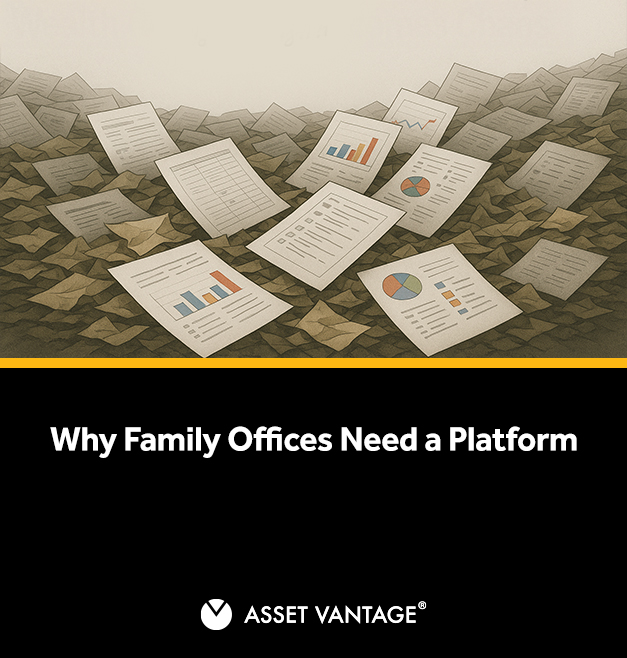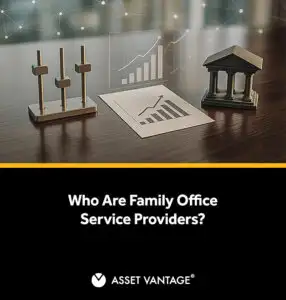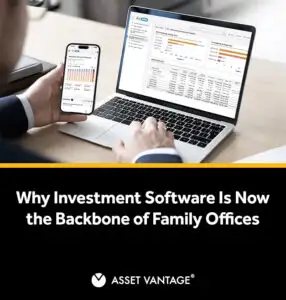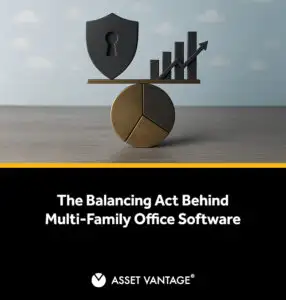Read Time17 Mins
- Why Family Offices Need a Platform
- Core Capabilities of a Family Office Platform
- Entity and Ownership Management
- Cash and Liquidity Visibility
- Private Equity and Alternative Investments Tracking
- Real Estate and Direct Holdings
- Tax, Audit, and Compliance Oversight
- Reconciliation Across Ledgers and Investment Data Aggregation
- Performance Reporting and Scenario Planning
- Operational Efficiency Through Automation
- Strategic Decision-Making Tools
- Continuity and Succession Management
- Governance Enforcement and Controls
- Advisors and Managers Workspace
- View of Wealth Across All Assets
- Platform Architecture and Software Solutions
- Spreadsheets vs Family Office Platforms: Key Challenges and Solutions
- Features Wealthy Families Expect in a Family Office Platform
- Investment Management and Oversight
- Asset Management and Equity Holdings
- Wealth Management and Advisory Integration
- AI-Powered Insights and Analytics
- Document Management and Private Data Security
- Entity and Ownership Management
- Cash and Liquidity Visibility
- Private Markets Tracking
- Tax, Audit, and Compliance Integration
- Reconciliation Across Ledgers
- Performance Reporting and Scenario Planning
- Operational Efficiency at Scale
- Strategic Decision-Making Tools
- Continuity and Succession Management
- Governance Enforcement and Controls
- Family Office Platforms vs Alternatives
- Key Decision Triggers for a Family Office Platform
- Choosing the Right Family Office Software
Why Family Offices Need a Platform
- Delays in consolidating financial data weaken investment analytics.
- Duplicate entries across systems create inaccurate reporting.
- Blind spots in governance leave principals unsure about exposures.
The Current State Without a Platform
- Performance reporting arrives late, making portfolio management reactive.
- Investment analytics are often incomplete, resulting in a lack of confidence in investment decisions.
- Business managers often get bogged down in reconciliation instead of guiding family wealth strategy.
Entity and Ownership Chaos
- Principals lack visibility into equity holdings across asset classes.
- Consolidated reports are slow, often arriving after tax deadlines.
- Errors in allocations lead to disputes among family members and beneficiaries.
Blind Spots in Cash and Liquidity
- Short-term borrowing replaces proactive liquidity planning.
- Idle cash stays uninvested, reducing portfolio performance.
- Principals lose confidence in reports that should guide financial decisions.
Private Equity and Alternative Investments Managed in Excel
- Capital calls and distributions are missed or miscalculated.
- Valuation errors create inaccurate reporting and compliance gaps.
- Investment firms and private equity managers face delays in consolidated reports.
Reconciliation Bottlenecks and Investment Data Aggregation Challenges
- Investment data aggregation remains inconsistent and labor-intensive.
- Consolidated reports still require duplicate tie-outs, which can produce errors.
- Families often hire additional staff to ensure accurate reporting, which increases costs.
Risks of Manual Systems
- Audit gaps remain unaddressed, increasing regulatory exposure.
- Service providers control critical records, limiting seamless access for family members.
- Cyber risk increases as sensitive information is circulated in unsecured formats.
Core Capabilities of a Family Office Platform
Entity and Ownership Management
- Consolidates trusts, partnerships, and holding companies into one ledger.
- Links ownership records to beneficiaries and individual wealth owners.
- Produces audit-ready roll-ups for tax, compliance, and governance.
Cash and Liquidity Visibility
- Distinguishes real cash from reserved or earmarked funds.
- Monitors short-term obligations across banks and entities.
- Forecasts liquidity needs before capital calls or tax deadlines arrive.
Private Equity and Alternative Investments Tracking
Real Estate and Direct Holdings
- Tracks property valuations, covenants, and rental income in one place.
- Preserves documents and appraisals alongside financial entries.
- Connects ownership records to entities and beneficiaries.
Tax, Audit, and Compliance Oversight
Reconciliation Across Ledgers and Investment Data Aggregation
- Automates investment data aggregation across providers.
- Reconciles accounting, banking, and investment ledgers on a daily basis.
- Locks reconciled periods to preserve prior results.
Performance Reporting and Scenario Planning
- Generates consolidated reports with live positions and prices.
- Provides portfolio analytics and investment analytics by asset class.
- Models “what-if” scenarios for reallocation or new commitments.
Operational Efficiency Through Automation
- Automates reconciliations, journal entries, and approvals.
- Reduces errors by minimizing manual data handling.
- Standardizes workflows across service providers and offices.
Strategic Decision-Making Tools
- Benchmark portfolios against indices and peers.
- Optimizes idle cash and supports data-driven asset allocation.
- Monitors exposures across strategies, regions, and asset classes.
Continuity and Succession Management
- Centralizes mandates, charters, and succession documents.
- Preserves permissions so family members always gain access.
- Maintains a full history of decisions and sign-offs.
Governance Enforcement and Controls
- Sets diversification rules, exposure limits, and approval thresholds.
- Triggers alerts when breaches occur and tracks the remediation process.
- Logs every change for governance reviews.
Advisors and Managers Workspace
- Provides secure access for wealth advisors, investment managers, and asset managers.
- Shares reports, notes, and tasks tied to live data.
- Aligns advice with actual book records and portfolio data.
View of Wealth Across All Assets
- Aggregates liquid, illiquid, and real estate positions.
- Presents wealth across all assets in one dashboard.
- Allows for seamless drill-down from portfolio to transaction.
Platform Architecture and Software Solutions
Features depend on a resilient foundation. Weak systems collapse under complexity.
- Provides secure, cloud-first software solutions with permissions and audit trails.
- Standardizes integrations with banks, custodians, and administrators.
- Maintains clear data lineage from source to report.
Spreadsheets vs Family Office Platforms: Key Challenges and Solutions
| Area | Challenge in Spreadsheets | How a Family Office Platform Solves It |
|---|---|---|
| Entity & Ownership Management | Ownership scattered across multiple Excel files; no audit trail; confusion in cross-border holdings. | Consolidates all entities and beneficiaries into one ledger with audit-ready reporting. |
| Cash & Liquidity | Balances look inflated; earmarked cash is not visible; liquidity crunches are discovered too late. | Real-time dashboards distinguish between real and reserved cash and forecast liquidity needs. |
| Private Equity & Alternative Investments | Capital calls and distributions are still tracked in spreadsheets at most family offices, where errors in waterfalls and delayed updates distort the picture. Commitments, calls, distributions, and valuations need to flow into the same system that tracks exposure and performance across entities and currencies. | A modern platform captures every commitment, records cash movements, and reflects valuations consistently across dashboards. IRR and multiples update as new data arrives, giving principals and advisors a clear view of exposure, liquidity needs, and fund performance without chasing spreadsheets. |
| Real Estate & Direct Holdings | Appraisals and leases are stored in separate files, which can easily lead to overlooked financing terms. | Tracks valuations, rental flows, loans, and covenants within the same system. |
| Tax, Audit & Compliance | Manual entry and spreadsheet reconciliations leave gaps that show up during audits. Foreign exchange and multi-currency postings are especially vulnerable, introducing inconsistencies across entities and jurisdictions. | A unified platform standardizes entries across currencies, maintains continuous audit trails, and highlights exceptions before they become filing issues. Advisors and controllers gain confidence that every report can withstand regulatory scrutiny, while families avoid the risk of last-minute surprises. |
| Reconciliation & Investment Data Aggregation | Banking, accounting, and custody data never align; manual tie-outs consume hours. | Automates data aggregation and reconciles ledgers daily, creating a single source of truth. |
| Performance Reporting & Scenario Planning | Reports arrive weeks late; scenarios are impossible to model in Excel. | Generates live consolidated reports, investment analytics, and scenario planning dashboards. |
| Operational Efficiency | Staff hours wasted on manual reconciliations; errors multiply as scale grows. | Automates reconciliations and workflows, reducing costs and error rates. |
| Strategic Tools | Limited to historical data; no benchmarks or forward-looking insight. | Benchmark portfolios, optimize asset allocation, and monitor exposures in real time. |
| Continuity & Succession | Institutional memory is often locked in staff knowledge, as records are lost due to staff turnover. | Centralizes charters, mandates, and succession files with full decision history. |
| Governance Controls | Policies are not enforced; breaches go unnoticed until it’s too late. | Enforces rules automatically, triggers alerts, and logs remediation steps. |
Features Wealthy Families Expect in a Family Office Platform
Investment Management and Oversight
- Integrating investment management, partnership accounting, and portfolio oversight into a single system.
- Running investment portfolio analysis across all asset classes using live financial data.
- Connecting transactions to entities and beneficiaries, ensuring reports are audit-ready and accurate.
- Providing benchmarking and scenario tools to guide allocations and test strategies.
Asset Management and Equity Holdings
Equity holdings rarely sit in one place. Families hold private investments, venture capital, and illiquid assets spread across entities, each with different reporting standards. For single-family offices and multi-family offices, this fragmentation makes it hard to assess risk, measure performance, or maintain valuation discipline. Platforms bring order through:
- Consolidating equity holdings into a single register, covering listed and unlisted assets.
- Automating valuation updates for private investments and illiquid assets.
- Providing portfolio analytics that highlight exposure, concentration, and asset allocation in real time.
- Linking holdings back to ownership structures for transparent reporting.
Wealth Management and Advisory Integration
- Providing secure access to live portfolio data for advisors and business managers.
- Aligning recommendations with real entity structures, mandates, and liquidity plans.
- Centralizing reports, notes, and compliance documents in one system.
AI-Powered Insights and Analytics
- Automating data capture and cleansing investment data aggregation across banks, custodians, and administrators.
- Generating portfolio oversight dashboards that highlight exposures and trends.
- Benchmarking portfolios against relevant indices and peer sets.
- Running liquidity forecasts and scenario planning with real-time inputs.
Document Management and Private Data Security
- Providing secure document management with access controls and audit trails.
- Protecting private data while ensuring files are linked to the right entities and transactions.
- Streamlining workflows and improving client service by making files easy to find.
Entity and Ownership Management
- Consolidating ownership records across all entities in one ledger.
- Tracking beneficiary allocations and their link to distributions.
- Aligning family office accounting software with tax and compliance requirements.
Cash and Liquidity Visibility
- Separating working capital from reserved funds across accounts.
- Providing real-time cash flow dashboards for principals and business managers.
- Forecasting liquidity crunches before they occur.
Private Markets Tracking
- Recording commitments, capital calls, distributions, valuations, and waterfalls.
- Projecting liquidity by aligning expected inflows with upcoming calls.
- Producing consolidated reports that tie accounting, cash flows, and performance together.
Tax, Audit, and Compliance Integration
- Capturing multi-currency entries directly in the GL, keeping IBOR and compliance records aligned.
- Reconciling FX automatically with complete, traceable audit trails.
- Embedding regulatory rules that surface exceptions for controllers to resolve early
Reconciliation Across Ledgers
- Automating reconciliation across the GL, banking systems, and custody feeds so the IBOR (Investment Book of Record) and ABOR (Accounting Book of Record) remain aligned.
- Aggregating data from custodians and administrators into one process.
- Locking reconciled periods to protect prior results and ensure continuity.
Performance Reporting and Scenario Planning
- Generating consolidated reports that update with new transactions and valuations.
- Drawing on the IBOR for real-time portfolio analytics while the GL anchors accounting accuracy across entities.
- Supporting scenario planning so families can test allocations and model outcomes before acting.
Operational Efficiency at Scale
- Automating reconciliations, approvals, and allocations.
- Reducing error rates by minimizing manual entries.
- Standardizing workflows across service providers and offices.
Strategic Decision-Making Tools
- Delivering portfolio management dashboards with live positions and exposures.
- Benchmarking results against indices and peer sets for context.
- Providing portfolio oversight that monitors drift and concentration.
- Enabling comparisons of allocations to support better financial decisions.
Continuity and Succession Management
- Centralizing ownership structures, beneficiary data, and family charters.
- Maintaining a full history of approvals, sign-offs, and mandates.
- Ensuring family members gain secure access to records when needed.
Governance Enforcement and Controls
- Embedding policy checks, such as exposure limits and diversification thresholds, to ensure compliance.
- Triggering alerts the moment a breach occurs.
- Capturing remediation steps and maintaining audit logs for review and analysis.
Family Office Platforms vs Alternatives
Compared to Single Family Offices with In-House Systems
- Delivering scale without constant system customization.
- Automating reconciliations across the GL, banking, and investment feeds.
- Ensuring accurate reporting and faster consolidation across entities.
- Lowering the long-term cost compared to building and maintaining custom systems.
Compared to Multi-Family Offices Using Shared Systems
- Supporting privacy controls for sensitive records.
- Generate consolidated reports tailored to each family’s structure.
- Reconciling investment, banking, and accounting data in real time.
- Maintaining compliance and audit logs specific to each client.
Compared to Wealth Managers and Service Providers
- Consolidating accounting and investment data into a single source of truth.
- Linking entity structures, ownership records, and tax requirements.
- Delivering live dashboards that reflect actual positions across asset classes.
- Supporting coordination between advisors, controllers, and principals.
Key Decision Triggers for a Family Office Platform
When Spreadsheets Fail
- Reconciling accounting entries in the GL (General Ledger) with positions held in the IBOR (Investment Book of Record) and ABOR (Accounting Book of Record).
- Recording adjustments and backdated transactions without breaking prior reports.
- Eliminating duplicate entries and improving controls across entities.
When Asset Classes Expand
- Consolidating all asset classes, from liquid securities to multi-asset private investments, in one system of record.
- Linking capital calls, waterfalls, and valuations back to the IBOR and GL.
- Supporting both current and backdated transactions for private markets.
When Families Demand Transparency
- Offering seamless access to consolidated wealth data through dashboards and portals.
- Producing reports that draw from the IBOR for investments and the GL for compliance.
- Maintaining full audit trails and logs that build trust in every number.
- Reflecting the impact of backdated transactions immediately, so reports always match reality.
When Governance and Risk Oversight Become Priorities
Good governance requires more than policies on paper. Families require enforcement systems that monitor risk in real-time. Platforms embed governance by:
- Setting automated policy checks for diversification, exposure limits, and approvals.
- Maintaining audit trails across the GL, IBOR, and ABOR.
- Flagging breaches instantly and recording remediation actions.
- Extending controls across multi-asset portfolios, not just listed securities.
Choosing the Right Family Office Software
Right Family Office Software vs Best Family Office Software
- Does the platform adapt to unique entity structures rather than force standard templates?
- Will it deliver operational resilience as complexity grows, not just surface-level performance reporting?
- Is the cost tied to actual value delivered, or inflated by functions meant for larger institutions?
What Business Managers Should Consider
- Can the platform automate reconciliations while sustaining operational efficiency?
- Does it handle reporting across complex partnership structures, not just simple portfolios?
- Will it scale as families add entities, jurisdictions, and new asset classes?
AI-Powered or Traditional Reporting Platforms?
- Aggregating portfolio data from banks, custodians, and administrators without manual uploads.
- Cleansing data and detecting anomalies before they distort results.
- Running scenario models that forecast liquidity, allocation shifts, and risk outcomes across multi-asset portfolios.
Evaluating Technology Solutions and Service Providers
- Secure sensitive records with resilient digital infrastructure and tested recovery processes.
- Support portfolio data consolidation across multiple custodians and partnership structures.
- Pair technology with managed services for onboarding, training, and audit readiness.
The right provider embeds the platform into the daily rhythm of the family office. The wrong one leaves families with software that looks capable but never delivers its promise.







